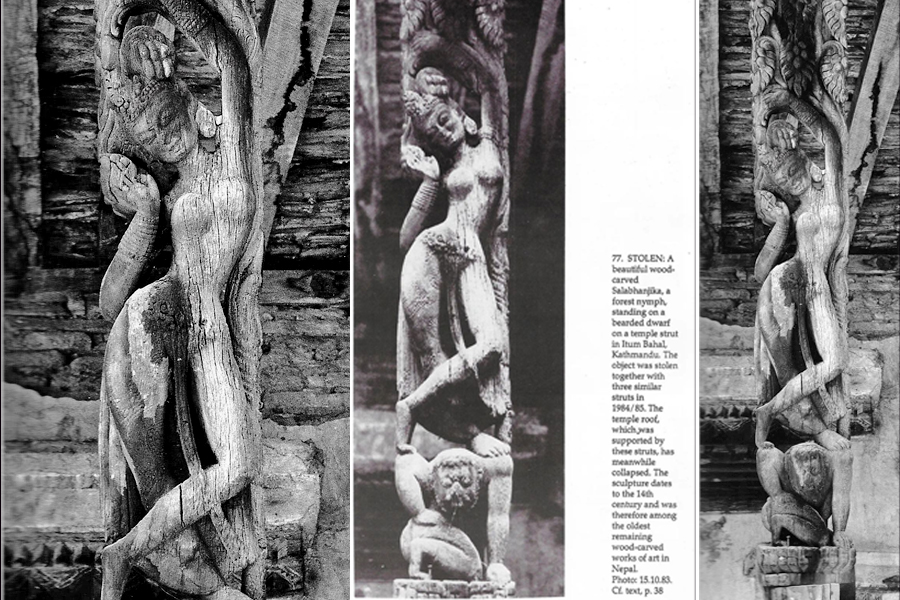There is an ancient broken wooden Yakṣa idol on the upper part of the Bhaskar Dev Sankarit Keshchandrakrit Paravat Mahavihar in Itumbaha, Kathmandu. Śālabhañjikā Yakṣiṇī which was formerly standing on the very broken idol suddenly disappeared in the mid-1980s along with three other similar struts.
At that time, such cases of idol theft were rampant in Nepal. Although the police conducted a general investigation on such cases, neither the whereabouts of those invaluable Nepali artefacts could be found nor the thief/thieves.
Thankfully, Bibek Sitaula, a student of archaeology at the University of the Highlands and Islands in Scotland and also a fellow of the Royal Society of the Arts, recently found one of those stolen idols of Yakṣiṇī at the Metropolitan Museum of Art in New York. According to him, the idol is kept in the museum’s storage and not for public display. And, that wooden sculpture is none other than the stolen statue of Śālabhañjikā Yakṣiṇī.
Sitaula has launched an effort to repatriate the idol back to Kathmandu in coordination with concerned government agencies as he believes it was stolen some 35 years ago.
How did he found so?
Many idols from Nepal have reached prestigious museums around the world. Out of them, one is the Metropolitan Museum of Art. According to Sitaula, Śālabhañjikā Yakṣiṇī is one of the most important wooden artworks in Nepal, presented to the museum by the collector Evelyn Kranes Kossak in 1991.
While checking the museum’s inventory during his study, this artwork caught Sitaula’s attention. “As soon as I saw the structure of the statue, I thought it might be one of the stolen or missing statues from Nepal and started researching further,” he says.
And, he found many pieces of evidence that prove it is the same idol of Śālabhañjikā Yakṣiṇī that reached the USA from Nepal. He stresses the need for Nepal to start the process of repatriation of the idol as soon as possible.
He says, “It is not difficult to prove that this ancient idol is from the premises of Itumbaha Mahavihar.”
What’s the evidence?

As per Sitaula, he based his findings on the photographic evidence provided by a book, ‘The Gods are Leaving the Country: Art Theft from Nepal by Jürgen Schick. On page 107 of that book, there is a photograph of the Śālabhañjikā Yakṣiṇī, taken on October 15, 1983, and there, Śālabhañjikā is seen standing on crouching Śālabhañjikā Yakṣa to which it was originally connected. Śālabhañjikā Yakṣiṇī is standing with her left foot attached to Yakṣa’s right elbow and her right foot resting on Yakṣa’s left shoulder.
Similarly, the photograph of Śālabhañjikā Yakṣiṇī is also included in the book The Antiquity of Nepalese Wood Carving: A Reassessment by Mary Shepherd Slusser, Kevin R Marsh and Paul Jett. Śālabhañjikā along with three similar caryatids were photographed by Slusser from 1969 to 1970.
It is estimated that this statue of Śālabhañjikā Yakṣiṇī was made between 770-970. According to Sitaula, the picture of this artwork was taken first in 1969/1970, then in 1983 and later in 2004 at the museum.
According to him, tests conducted by Florida’s Beta Analytic Radiocarbon Dating Laboratory have shown that the wooden statue was made during the post-Lichhavi transition period. “If we trust carbon dating, Śālabhañjikā is one of the oldest and longest-lived woodcarving products in Nepal,” he says.
The size of the statue of Śālabhañjikā Yakṣiṇī in the museum is ‘131.5 × 21 cm’. However, the actual size can be known by adding the height of the rest of the Yakṣa idol left in Nepal.
Mona Lisa of the East
This sculpture is also very notable because of its exceptional beauty and craftsmanship. Śālabhañjikā Yakṣiṇī is standing in the classic posture of Tribhanga, with her legs crossed, on Yakṣa, who is kneeling on the rock.
Śālabhañjikā Yakṣiṇī is holding the foliage above her hand. According to Sitaula, such a special asana is called ‘Śālabhañjikā’. It means one who breaks the branch of the śāla tree. Śālabhañjikā’ has a narrow waist, with a slim torso and ample hips and breasts. She has full lips with an enigmatic smile, a square face with large eyes, and high cheekbones.
Sitaula describes, “Sadly, the nose is damaged. Typically, her hair is drawn into a large chignon similar to the coiffure of an eighth-century.”
Śālabhañjikā Yakṣiṇī is adorned with jewels including crowns, earrings, necklaces, and rings. According to Sitaula, these are the ornaments of the Bajrapani period. There are no foot ornaments nor any anklets, which is a new aspect of this idol, says Sitaula.
Sitaula calls this idol the Mona Lisa of the East. He describes, “This statue is very attractive. It looks supernatural. Śālabhañjikā with a smile can be called the Mona Lisa of the East.”
Bhaskar Dev Sankarit Keshchandrakrit Paravat Mahavihar, however, did not know much about this idol. Pragya Ratna Shakya, the president of the Mahavihar Samrakshan Samaj, says the broken parts of the old wooden idols taken out during the renovation of the building might have been taken away.
What the government should do now?
Sitaula says that the government of Nepal must show readiness to repatriate Śālabhañjikā Yakṣiṇī to meet Yakṣa. In the process, he has already sent a request with the evidence to the Nepali Embassy in Washington DC to take the process of repatriation forward.
“Besides, I have also sent letters to the Department of Archaeology and Nepal Academy,” he says, “Our precious treasure is stored elsewhere. This cannot be ignored by the concerned bodies.”
The UNESCO 1970 Convention on the Means of Prohibiting and Preventing the Illicit Import, Export and Transfer of Ownership of Cultural Property has a provision that idols smuggled abroad can be repatriated to their own country without compensation.
“We urge the government to fulfil its obligation to repatriate Śālabhañjikā Yakṣiṇī as soon as possible,” he says.




















